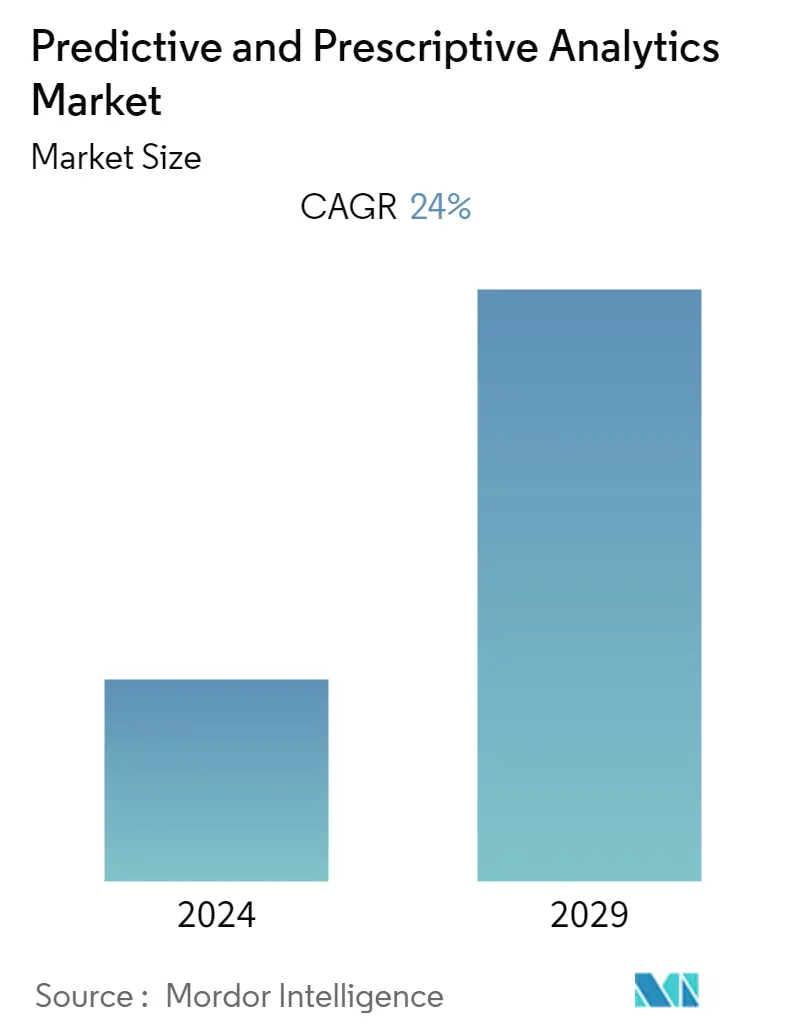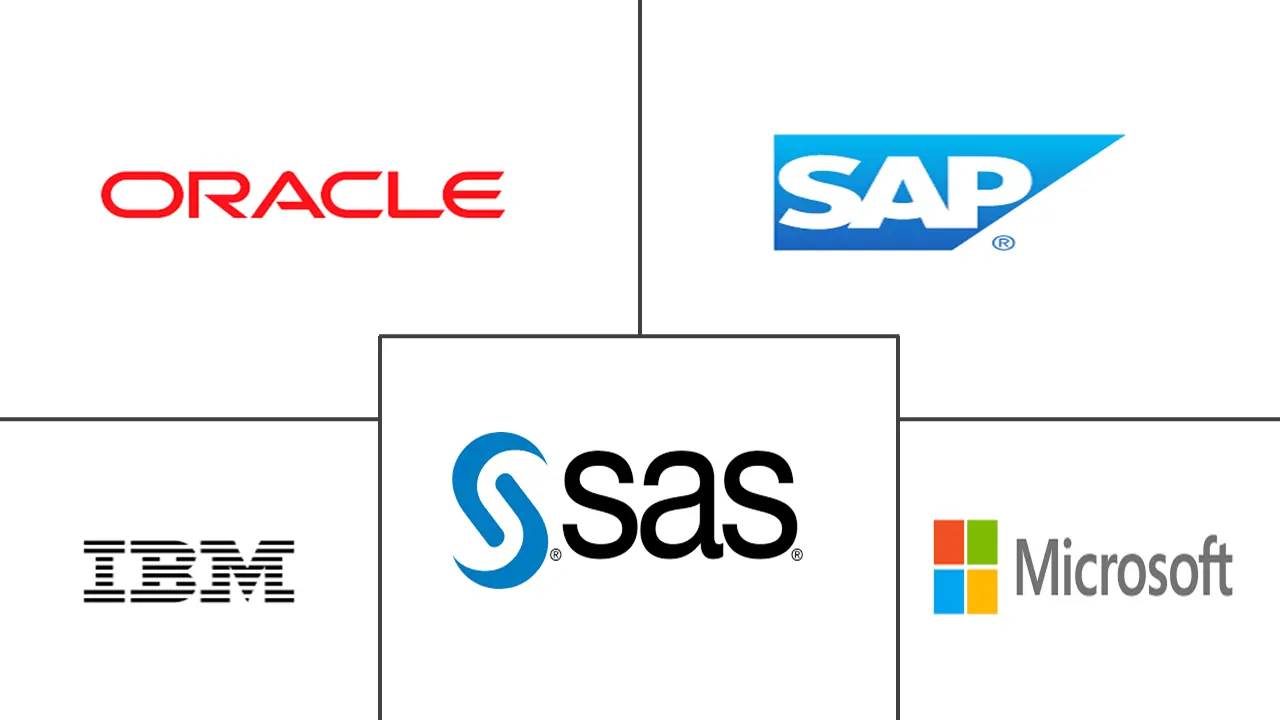Market Size of Predictive and Prescriptive Analytics Industry

| Study Period | 2019 - 2029 |
| Base Year For Estimation | 2023 |
| CAGR | 24.00 % |
| Fastest Growing Market | Asia Pacific |
| Largest Market | North America |
| Market Concentration | Medium |
Major Players
*Disclaimer: Major Players sorted in no particular order |
Predictive and Prescriptive Analytics Market Analysis
The predictive and prescriptive analytics market will register a CAGR of 24% over the forecast period. Various factors include increased spending on marketing advertising by enterprises and changing customer intelligence landscape to drive market growth.
- Further, using data-driven insights, predictive analytics provides businesses with actionable information. It offers estimations of how likely a given outcome is to occur. Enterprises use these facts to estimate future trends. Predictive analytics is also built on probability as its underlying principle.
- Machine learning (ML), algorithms, business rules, and computational modeling techniques are some methods and equipment used in prescriptive analytics. Input for this technique comes from various data sources, including historical and transactional data, real-time data feeds, and big data. Companies and organizations already using descriptive analytics tools and solutions are more prepared to deploy predictive and prescriptive analytics solutions. They employ these solutions more successfully since they have historical data to forecast from and run algorithms.
- Advanced analytics solutions provide strategies to address these issues using statistical and technical approaches, ultimately assisting in making strategic and fact-based decisions. As a result, analytics are crucial for Business Intelligence (BI) in many different end-user industries.
- Security and data privacy concerns have been brought up. Users are concerned about the confidentiality of the collected data because of the information generated on behavioral aspects.
- The COVID-19 emergence slowed the market growth, but the market is gradually gaining traction due to uplifting lockdowns. It provided several opportunities for businesses to digitalize and expand throughout the region as the adoption of technologies like cloud and AI increased during the lockdowns.
Predictive and Prescriptive Analytics Industry Segmentation
Predictive analytics describes any approach to data mining, emphasizing prediction (rather than description, classification, or clustering). Prescriptive analytics is a form of advanced analytics which examines data or content and is characterized by techniques such as graph analysis, simulation, complex event processing, neural networks, recommendation engines, heuristics, and machine learning.
The Predictive and Prescriptive Analytics Market is segmented by end-user industry (BFSI, healthcare, retail, IT and telecom, industrial (manufacturing, automotive, and energy and mining), government, defense, and other end-user industries) and geography (North America, Europe, Asia-Pacific, Latin America, and Middle East and Africa).
The market sizes and forecasts are in terms of value (USD million) for all the above segments.
| By End-user Industry | |
| BFSI | |
| Healthcare | |
| Retail | |
| IT and Telecom | |
| Industrial (Manufacturing, Automotive, and Energy and Mining) | |
| Government and Defense | |
| Other End-user Industries |
| By Geography | |
| North America | |
| Europe | |
| Asia-Pacific | |
| Latin America | |
| Middle East and Africa |
Predictive and Prescriptive Analytics Market Size Summary
The predictive and prescriptive analytics market is experiencing significant growth, driven by increased enterprise spending on marketing and the evolving landscape of customer intelligence. This market leverages data-driven insights to provide businesses with actionable information, helping them estimate future trends and outcomes based on probability. The integration of machine learning, algorithms, and computational modeling techniques enhances the capabilities of prescriptive analytics, utilizing data from various sources such as historical, transactional, and real-time feeds. The adoption of these advanced analytics solutions is particularly strong in industries like BFSI, where they are used to forecast growth, develop strategies, and identify potential customers. Despite concerns over data privacy and security, the market is gaining traction as businesses recognize the value of analytics in making strategic, fact-based decisions.
In North America, the United States leads the market due to its early adoption of advanced analytics across various sectors, including retail and healthcare. The predictive analytics market is also expanding in Canada, which is at the forefront of cloud adoption. The market is moderately competitive, with a few major players dominating and focusing on product differentiation and innovation to maintain their edge. Companies like Oracle, SAP, and IBM are actively enhancing their offerings through strategic acquisitions and advancements in AI-driven analytics. These developments are aimed at empowering organizations to make informed, data-driven decisions, further driving the growth and adoption of predictive and prescriptive analytics solutions globally.
Predictive and Prescriptive Analytics Market Size - Table of Contents
-
1. MARKET INSIGHTS
-
1.1 Market Overview
-
1.2 Industry Attractiveness - Porter's Five Forces Analysis
-
1.2.1 Bargaining Power of Suppliers
-
1.2.2 Bargaining Power of Buyers
-
1.2.3 Threat of New Entrants
-
1.2.4 Threat of Substitutes
-
1.2.5 Intensity of Competitive Rivalry
-
-
1.3 Assessment of the Impact of COVID-19 on the Market
-
-
2. MARKET SEGMENTATION
-
2.1 By End-user Industry
-
2.1.1 BFSI
-
2.1.2 Healthcare
-
2.1.3 Retail
-
2.1.4 IT and Telecom
-
2.1.5 Industrial (Manufacturing, Automotive, and Energy and Mining)
-
2.1.6 Government and Defense
-
2.1.7 Other End-user Industries
-
-
2.2 By Geography
-
2.2.1 North America
-
2.2.2 Europe
-
2.2.3 Asia-Pacific
-
2.2.4 Latin America
-
2.2.5 Middle East and Africa
-
-
Predictive and Prescriptive Analytics Market Size FAQs
What is the current Predictive and Prescriptive Analytics Market size?
The Predictive and Prescriptive Analytics Market is projected to register a CAGR of 24% during the forecast period (2024-2029)
Who are the key players in Predictive and Prescriptive Analytics Market?
Oracle Corporation, SAP SE, Microsoft Corporation, SAS Institute Inc. and IBM Corporation are the major companies operating in the Predictive and Prescriptive Analytics Market.

